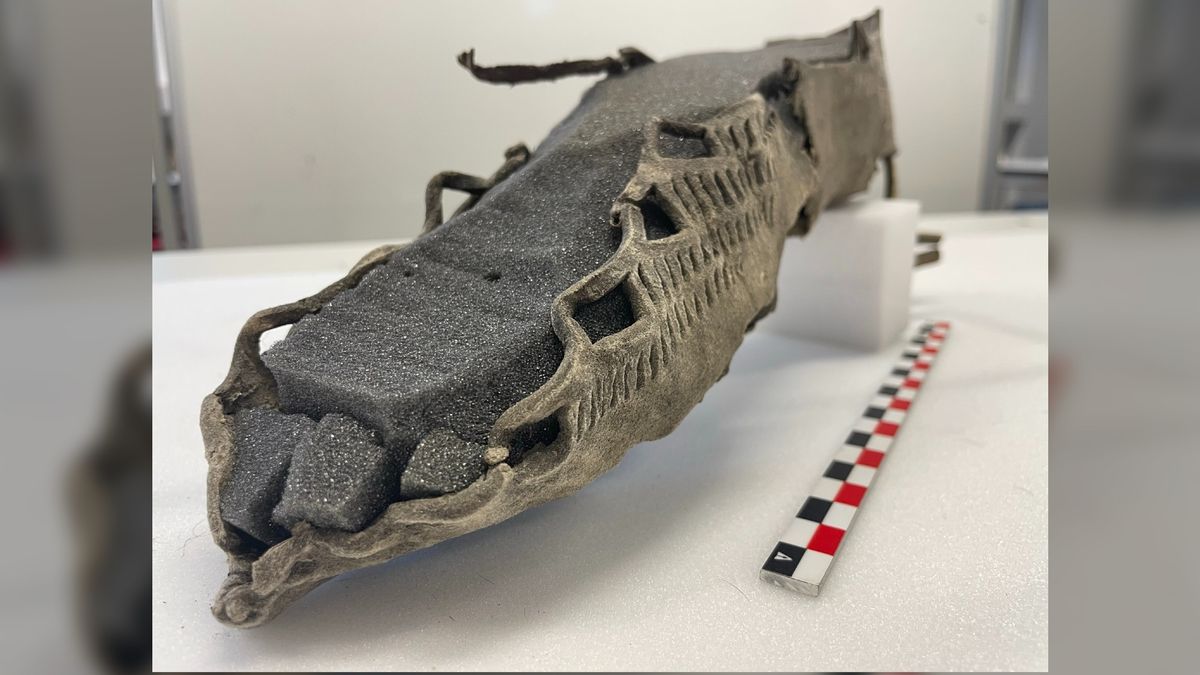1,700-year-old sandal found on a remote mountain in Norway
The sandal reveals that humans historically used the icy pass.

The discovery of an Iron Age sandal on an icy Norwegian mountain provides more evidence that the mountain served as a travel route about 1,700 years ago.
A mountain hiker found the sandal in an area known as the Horse Ice Patch in late August 2019. The hiker contacted researchers at Secrets of the Ice, who study archaeology preserved within glaciers and ice patches.
"He sent us GPS coordinates and photos, and left the discovery in the ice. Well done," Espen Finstad, the archaeologist responsible for the fieldwork and report from the site, told Live Science in an email.
Related: Photos: Ancient arrows from reindeer hunters found in Norway
As the archaeologists prepared to retrieve the shoe, they realized that the forecast predicted snow, which could blanket the find. "Then it could take many years before it melted out again," Finstad said. "We archaeologists had a day to go in and collect the find," which they did on Sept. 2, 2019, but "it was a long day."
Once the archaeologists recovered the sandal, they radiocarbon-dated the footwear to about A.D. 300. The Secrets of the Ice team has also found other artifacts, such as textiles, in this area, but none are as old as the sandal. The team announced the find on Twitter on April 8.
The sandal and other finds, such as frozen horse manure that dates to the Viking Age (about A.D. 800 to 1066), show that a route across the icy mountain connected inland Norway to the coast. "I believe the people who walked these routes most likely knew what they were doing. They would have worn something inside this shoe that made it work. Perhaps scraps of fabric or animal skin," Finstad told Science Norway, a Norwegian news site.
Sign up for the Live Science daily newsletter now
Get the world’s most fascinating discoveries delivered straight to your inbox.
"We have found cairns [human-made rock stacks] that show where the route has gone," said Finstad, who began investigating the area in 2010. Perhaps a person traveling with goods was wearing the shoe but tossed it on the mountainside once it somehow became damaged, he added.
The sandal also sheds light on the people who used the mountain more than a millennium ago.
"It tells us that what today looks like a wild and desolate mountain landscape has been a prehistoric traffic landscape, and that it is full of traces of humans," Finstad said. "People have not been afraid to move out into tough mountain areas. They have traveled long distances and had contact and exchange." Moreover, "The shoe is inspired by fashion in the Roman Empire," indicating that people who traversed the Norwegian mountain had contact with the outside world, Finstad said.
Other finds from the mountain pass reveal that hunters frequented the site. Arrowheads and shafts, dating to approximately 2,000 to 3,000 years ago, suggest the area was used by people pursuing reindeer on the ice, Live Science previously reported.
However, the importance of the sandal to understanding the later use of this site is immeasurable. "There are currently not many discoveries related to traffic in this mountain pass," Finstad said. "But the finds in the ice, together with cairns and other tracks, tell a clear story.
"Hundreds of finds have been made on Lendbreen [a nearby mountain pass], including several shoes, but none of those shoes are as old as the shoe from the 300s, and no[t] one is similar to this shoe," he said.
Originally published on Live Science.
Emily is the Staff Writer at All About History magazine, writing and researching for the magazine's content. She has a Bachelor of Arts degree in History from the University of York and a Master of Arts degree in Journalism from the University of Sheffield. Her historical interests include Early Modern and Renaissance Europe, and the history of popular culture.











